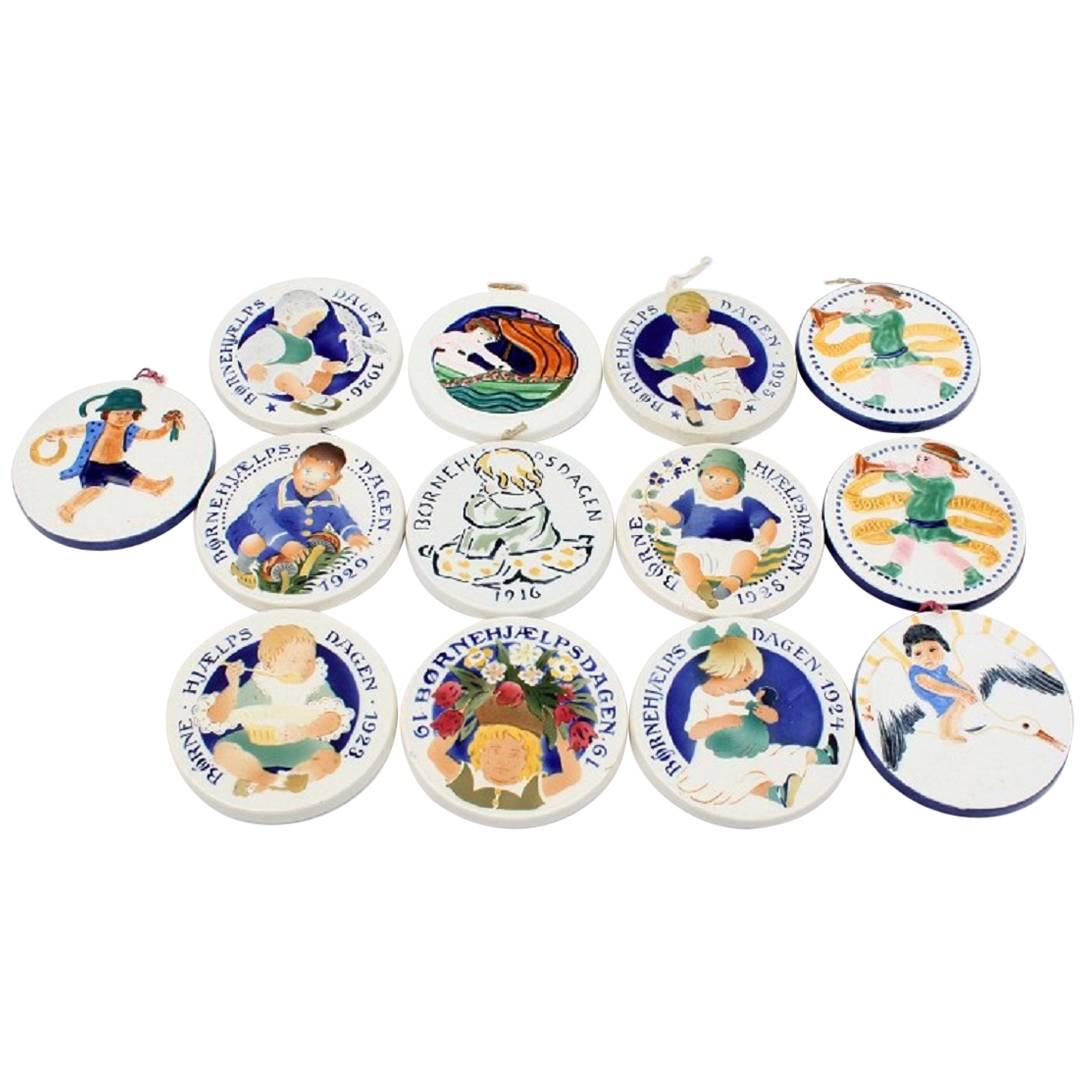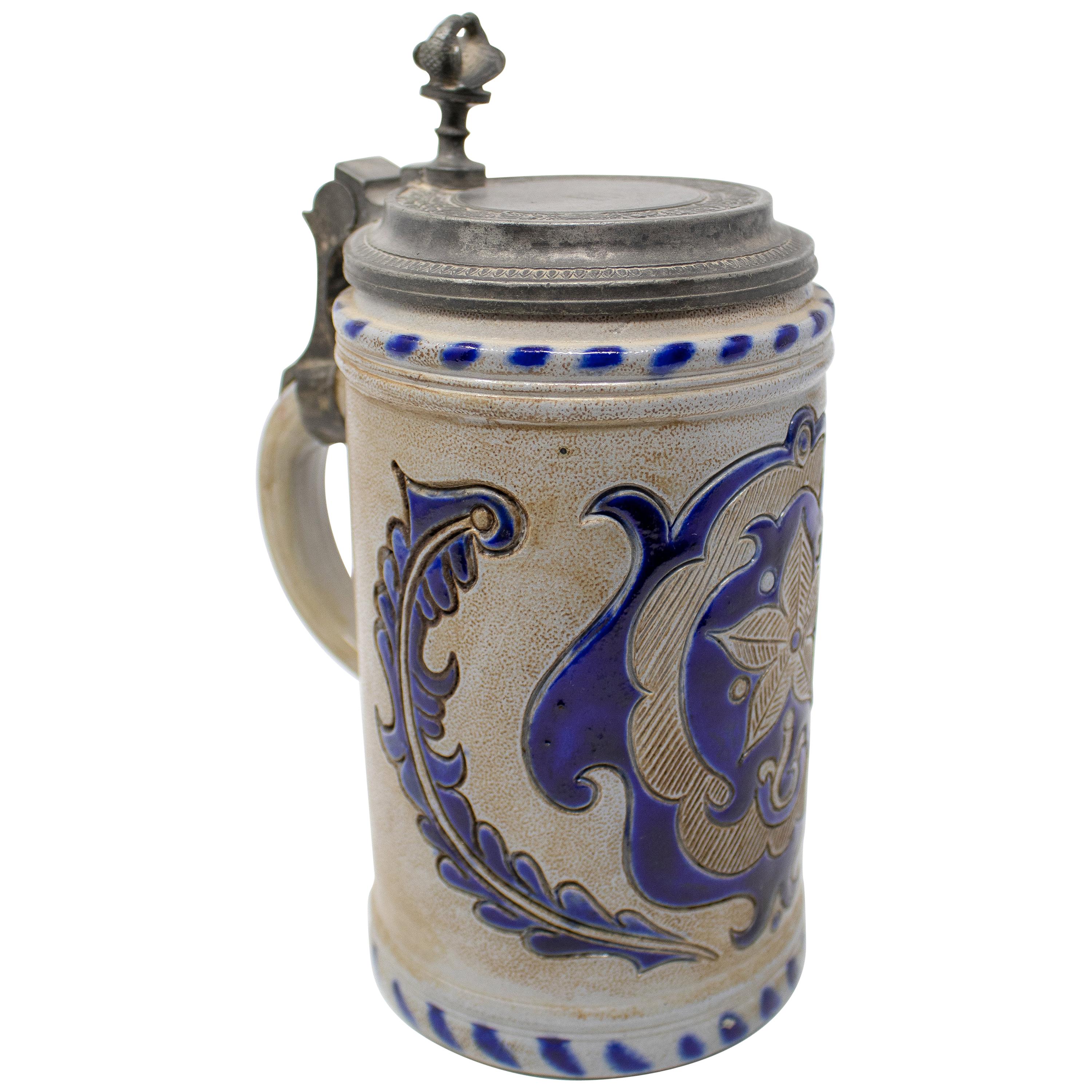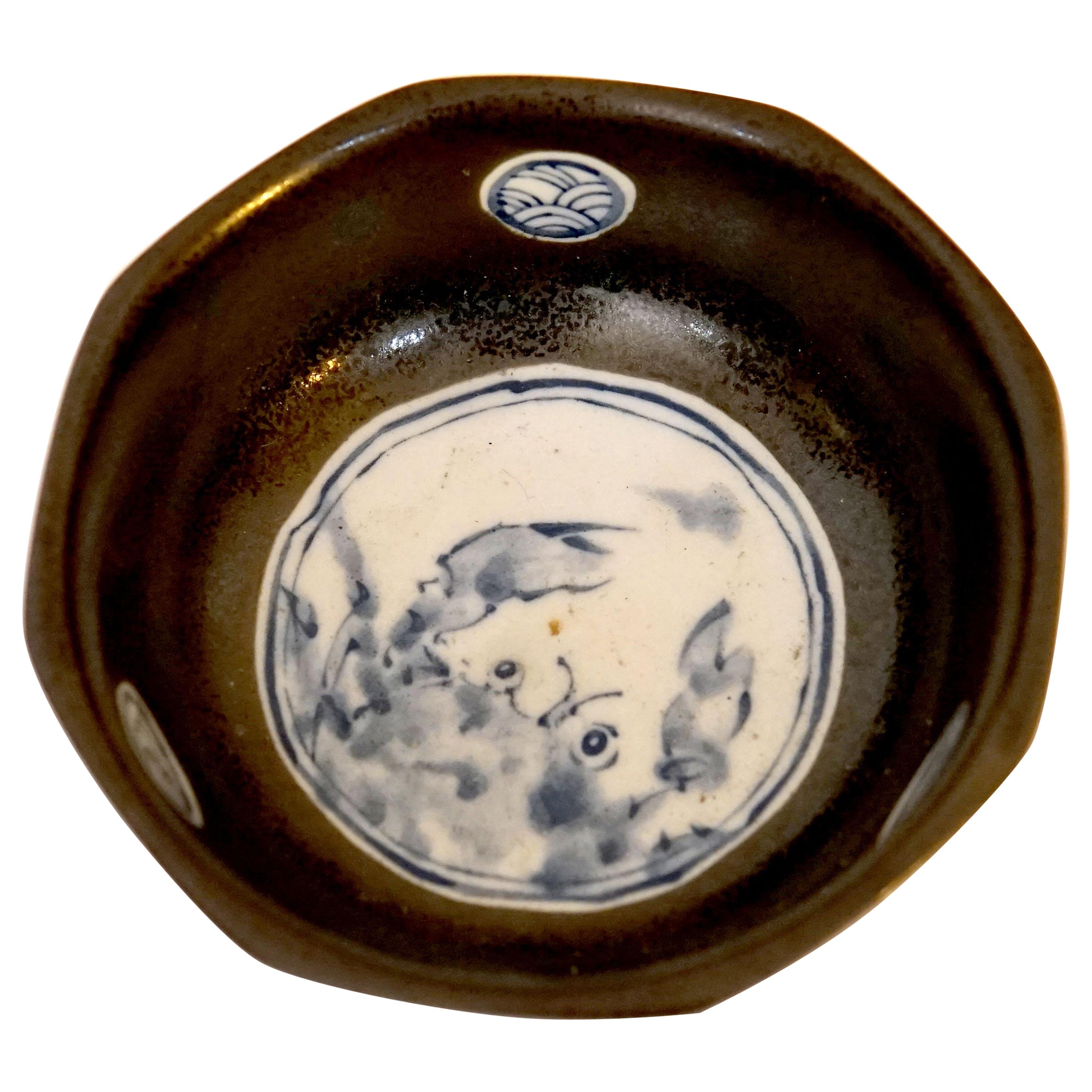Items Similar to Earthenware John Bennett Plaque with Pink and Blue Phlox
Want more images or videos?
Request additional images or videos from the seller
1 of 6
Earthenware John Bennett Plaque with Pink and Blue Phlox
About the Item
FAPG 20247D
John Bennett (1840-1907), New York
Plaque with pink and blue phlox, circa 1881-1882
Earthenware, painted and glazed
Measures: 14 7/8 in. diameter, 1 13/16 in. high
Signed and inscribed (on the back): J B[monogram] ENNETT /
E 24 NY. / MC [or] CM
If the Herter Brothers was the most distinguished and successful cabinet making and decorating firm in New York in the 1870s-1880s, the transplanted Englishman John Bennett was probably the most gifted ceramicist working in New York in the Aesthetic period. (Bennett was included in The Metropolitan Museum of Art’s landmark exhibition, In pursuit of beauty: Americans and the Aesthetic Movement, in 1986–87, and Alice Cooney Frelinghuysen’s chapter, “Aesthetic Forms in Ceramics and Glass,” pp. 216–19, significantly informs this essay). Born in England, the son of a potter who worked in the Staffordshire district, Bennett came under the influence of John Sparkes, head of London’s Lambeth School of Art. Soon thereafter, he was hired by Henry Doulton of the eponymous firm to teach artisans there the new art of underglaze faience decoration, which was part of a revival of the sixteenth-century interest in hand-painted ceramics.
A number of Bennett’s works for Doulton were shown in the Doulton display at the Centennial Exposition in Philadelphia in 1876, and the considerable success enjoyed by Bennett and Doulton from an American audience undoubtedly played an important role in Bennett’s decision to leave Doulton and England and set up shop in New York in 1877. By the next year, he had already established a studio in New York, where he produced his own pottery in the tradition of the Arts & Crafts innovators, William Morris and William De Morgan, and also taught classes at the new Society of Decorative Art to the growing band of women who had taken up china painting, both professionally and avocationally.
Bennett’s pottery developed a very serious following among students and collectors, and was offered for sale at such leading retail establishments as Tiffany & Company in New York. Typically, his work was brilliantly colored, with carefully drawn naturalistic flowers against a monochromatic background.
Bennett’s fully developed American work, particularly pieces of larger scale, is exceedingly rare, as he worked in New York only from 1877 to 1883, in which year he withdrew to a farm in rural West Orange, New Jersey, where his production continued on a limited basis. He remained listed as a ceramicist there until 1889. While in New York City, Bennett maintained a studio at 412 East 24th Street. The present charger, boldly featuring pink and blue phlox, is signed by Bennett, and is inscribed “E 24 NY,” indicating its manufacture during Bennett’s time in New York. Although it is not dated, this piece is closely related stylistically to various dated pieces from 1881–82, which would place its production toward the end of Bennett’s New York years.
Although we do not know whether Bennett worked out of this 24th Street studio from the outset, he was indeed working there by 1879 when he made (and signed, inscribed, and dated) a charger with white and red flowers now in the collection of the Art Institute of Chicago, which specifically points to “412 East 24 / NY” (acc. no. 1998.317). Additionally, the U.S. Census of 1880 lists Bennett as a ceramicist located at that same address, married to Mary Bennett with whom he had had six children. There are several other examples from Bennett’s time in New York City, which also give his studio address on East 24th Street, including a covered jar in cadmium yellow with indigo and green flowers made in 1881; an undated footed vase with lilac decoration in the collection of the Museum of Fine Arts, Boston (acc. no. 2008.109); and a covered jar painted with peonies in yellow and white on a burgundy ground, also undated.
Condition: Perfect.
- Creator:John Bennett (Maker)
- Dimensions:Height: 1.82 in (4.63 cm)Width: 14.75 in (37.47 cm)Depth: 14.75 in (37.47 cm)
- Style:Aesthetic Movement (Of the Period)
- Materials and Techniques:Earthenware,Glazed
- Place of Origin:
- Period:
- Date of Manufacture:circa 1881-1882
- Condition:CONDITION: Perfect.
- Seller Location:New York, NY
- Reference Number:
About the Seller
No Reviews Yet
Recognized Seller
These prestigious sellers are industry leaders and represent the highest echelon for item quality and design.
Established in 1952
1stDibs seller since 2010
Associations
Art Dealers Association of America
- ShippingRetrieving quote...Ships From: New York, NY
- Return PolicyThis item cannot be returned.
More From This SellerView All
- Bowl with Dogwood BlossomsBy John BennettLocated in New York, NYBowl with Dogwood Blossoms, 1882 John Bennett (1840–1907) Earthenware, painted and glazed 4 in. high, 7 5/8 in. diameter Signed, dated, and inscribed (...Category
Antique 19th Century American Aesthetic Movement Decorative Bowls
MaterialsEarthenware
- Plateau in the Restauration Taste with Grape and Leaf MotifsLocated in New York, NYFrench. Plateau in the Restauration taste with grape and leaf motifs, circa 1825. Ormolu and patinated bronze, with mirror plate and wood backing. Measures: 15 7/8 in. diameter, 3 11...Category
Antique 1820s French Neoclassical Platters and Serveware
MaterialsBronze
- Center Table with Scroll Legs, Paw Feet and Marble TopsBy Thomas SeymourLocated in New York, NYCenter Table, about 1818–20 Attributed to Thomas Seymour (1771–1848), working either for James Barker or for Isaac Vose & Son, with Thomas Wightman (1759...Category
Antique 1810s American American Classical Center Tables
MaterialsMahogany, Wood
- Pair of Porcelain Urn Form Fruit Coolers with Covers and LinersBy Stône, Coquerel, and Legros d'AnisyLocated in New York, NYPair Footed Fruit Coolers, about 1810-20 Stône, Coquerel, and Legros D’Anisy, Paris (active 1808–49) Porcelain, partially transfer printed in sepia and green and gilded Each, 13 1/2 in. high x 10 in. wide x 7 1/2 in. deep Signed and inscribed (on underside of one top and one base, with printed mark): STÔNE / COQUEREL / ET / LE GROS / PARIS / PAR BREVET D’INVENTION: Manufre de Décors sur Porcelaine Faience; variously inscribed with decorators’ initial in green and brown (on underside of one top and one base): M; variously inscribed with incised mark (on underside of one liner and both bottoms): 3; inscribed (in blue script, on the inside of one liner): 615 The Parisian firm of Stône, Coquerel, and Legros d'Anisy is distinguished for the important role that it played in the introduction of transfer-printed decoration on fine china in France. Although the process had been known and used in Great Britain since the eighteenth century, it was, according to Régine de Plinval de Guillebon in her book, Porcelain of Paris 1770–1850 (New York: Walker and Company, 1972), not until 1802 that Potter, Blancheron, Constant, Neppel, Cadet de Vaux & Denuelle took out a patent in France for transfer-printing on earthenware, and it was only on February 26, 1808, that John Hurford Stône, his brother-in-law, Athanase Marie Martin Coquerel, and Francois Antoine Legros d'Anisy not only took out a patent for transfer-printing on china, but also established a Stône, Coquerel, and d'Anisy partnership for the manufacture of transfer-printed ceramics. Their address from 1808 until 1818 was at 9, rue de Cadran, Paris. Prior to this, Stône and Coquerel had been partners at a creamware factory in Creil, France, and Legros d’Anisy had worked at the Sèvres factory, where he had apparently developed the transfer-printing technique for which his own firm became well known. “The process,” notes de Guillebon, was “based upon removing from the engraving a ‘pull’ made on a specially coated filter-paper, which was pressed onto the object to be decorated; this object itself was covered with a film. Firing took...Category
Antique Early 19th Century French Neoclassical Wine Coolers
MaterialsPorcelain
- Pair of Fern Wall BracketsLocated in New York, NYAmerican, circa 1850-1880. Eastern white pine (Pinus strobus), with wire armature and composition ornament, gessoed and gilded. Measures: 14 1/8 in. high, 16 5/16 in. wide (at the sh...Category
Antique 19th Century American Aesthetic Movement Wall Brackets
MaterialsWood
- Monumental Overmantel or Pier Mirror in the Aesthetic TasteLocated in New York, NYAmerican, third quarter of the 19th century. Pine, gessoed and gilded, with mirror plate. Measures: 81 ½ in. high, 59 ½ in. wide. Condition: Excellent. The gilding has been cleaned and very, very slightly inglided as necessary. The ball at the upper left was missing and has been replicated based upon...Category
Antique 19th Century American Aesthetic Movement Pier Mirrors and Consol...
MaterialsMirror, Pine
You May Also Like
- Aluminia Plaques Earthenware, 13 Pieces, BørnehjælpsdagenLocated in Copenhagen, DKAluminia plaques earthenware, 13 pieces. Børnehjælpsdagen. Diameter 9 cm. In good condition. Stamped.Category
20th Century Danish Scandinavian Modern Ceramics
- S & B Evans, London Earthenware Pottery Grotesque PlaqueLocated in Bishop's Stortford, HertfordshireAn unusual and well made mid-century earthenware glazed grotesque plaque by S & B Evans & Sons, Earthenware Potters, London. The heavily made plaque is hand crafted and molded in red...Category
Mid-20th Century English Mid-Century Modern Ceramics
MaterialsEarthenware
- 19th Century German Earthenware Beer Stein with Tin Lid and Cobalt BlueLocated in Marbella, ES19th century German earthenware beer stein mug with tin lid and cobalt blue ornamental decoration.Category
Antique Late 19th Century German Ceramics
MaterialsTin
- Orange And Blue Textured Spiral Earthenware Vase, U.S.A., ContemporaryLocated in New York, NYContemporary textured ceramic earthenware vase. Orange body with a textured spiral design and gradient blue band. The glaze has a crackle effect giving it an ancient feel. Tiny to...Category
21st Century and Contemporary American Vases
MaterialsEarthenware
- Orange and Blue Textured Small Earthenware Vase, U.S.A., ContemporaryLocated in New York, NYContemporary small textured ceramic earthenware vase. Blue and orange glaze has a crackle effect giving it an ancient feel. Tiny top spout. Hand made one of a kind. Part of a col...Category
21st Century and Contemporary American Vases
MaterialsEarthenware
- Korean Hexagonal Blue and White Ceramic Glazed Earthenware BowlLocated in Lomita, CAA small vintage Korean black glazed and blue and white octagonal faceted earthenware bowl is probably from the mid 20th Century. The contrast between the dark brown glaze and the blu...Category
Mid-20th Century South Korean Han Ceramics
MaterialsCeramic
Recently Viewed
View AllMore Ways To Browse
Pink And Silver
John Antique Furniture
Pink And White Glass
Pink Blue Glass
Pink Green Glass
Antique Pink Glasses
Antique Pink Glass
Pink Glass Antique
Pink Antique Glass
Pink Antique Glasses
Large Pink Glass
Blue Red Green Glass
Pink Glass Flower
Pink Glass Collection
Yellow Pink Glass
Yellow And Pink Glasses
Blue Glass Head
Antique Silver Scale





